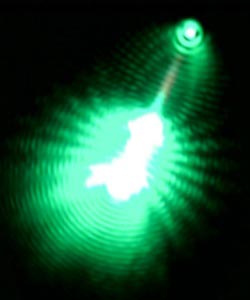Penn Researchers Make First All-optical Nanowire Switch

Laser light is emitted from the end of a cadmium sulfide nanowire.<br>
Researchers at the University of Pennsylvania have made an important advance in this frontier of photonics, fashioning the first all-optical photonic switch out of cadmium sulfide nanowires. Moreover, they combined these photonic switches into a logic gate, a fundamental component of computer chips that process information.
The research was conducted by associate professor Ritesh Agarwal and graduate student Brian Piccione of the Department of Materials Science and Engineering in Penn’s School of Engineering and Applied Science. Post-doctoral fellows Chang-Hee Cho and Lambert van Vugt, also of the Materials Science Department, contributed to the study.
It was published in the journal Nature Nanotechnology.
The research team’s innovation built upon their earlier research, which showed that their cadmium sulfide nanowires exhibited extremely strong light-matter coupling, making them especially efficient at manipulating light. This quality is crucial for the development of nanoscale photonic circuits, as existing mechanisms for controlling the flow of light are bulkier and require more energy than their electronic analogs.
“The biggest challenge for photonic structures on the nanoscale is getting the light in, manipulating it once it's there and then getting it out,” Agarwal said. “Our major innovation was how we solved the first problem, in that it allowed us to use the nanowires themselves for an on-chip light source.”
The research team began by precisely cutting a gap into a nanowire. They then pumped enough energy into the first nanowire segment that it began to emit laser light from its end and through the gap. Because the researchers started with a single nanowire, the two segment ends were perfectly matched, allowing the second segment to efficiently absorb and transmit the light down its length.
“Once we have the light in the second segment, we shine another light through the structure and turn off what is being transported through that wire,” Agarwal said. “That's what makes it a switch.”
The researchers were able to measure the intensity of the light coming out of the end of the second nanowire and to show that the switch could effectively represent the binary states used in logic devices.
“Putting switches together lets you make logic gates, and assembling logic gates allows you to do computation,” Piccione said. “We used these optical switches to construct a NAND gate, which is a fundamental building block of modern computer processing.”
A NAND gate, which stands for “not and,” returns a “0” output when all its inputs are “1.” It was constructed by the researchers by combining two nanowire switches into a Y-shaped configuration. NAND gates are important for computation because they are “functionally complete,” which means that, when put in the right sequence, they can do any kind of logical operation and thus form the basis for general-purpose computer processors.
“We see a future where ‘consumer electronics’ become ‘consumer photonics’,” Agarwal said. “And this study shows that is possible.”
The research was supported by the U.S. Army Research Office and the National Institutes of Health’s New Innovator Award Program.
Media Contact
More Information:
http://www.upenn.eduAll latest news from the category: Physics and Astronomy
This area deals with the fundamental laws and building blocks of nature and how they interact, the properties and the behavior of matter, and research into space and time and their structures.
innovations-report provides in-depth reports and articles on subjects such as astrophysics, laser technologies, nuclear, quantum, particle and solid-state physics, nanotechnologies, planetary research and findings (Mars, Venus) and developments related to the Hubble Telescope.
Newest articles

Trotting robots reveal emergence of animal gait transitions
A four-legged robot trained with machine learning by EPFL researchers has learned to avoid falls by spontaneously switching between walking, trotting, and pronking – a milestone for roboticists as well…

Innovation promises to prevent power pole-top fires
Engineers in Australia have found a new way to make power-pole insulators resistant to fire and electrical sparking, promising to prevent dangerous pole-top fires and reduce blackouts. Pole-top fires pose…

Possible alternative to antibiotics produced by bacteria
Antibacterial substance from staphylococci discovered with new mechanism of action against natural competitors. Many bacteria produce substances to gain an advantage over competitors in their highly competitive natural environment. Researchers…





















